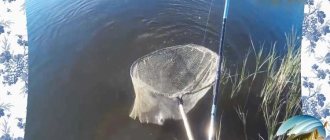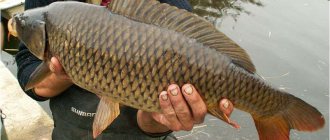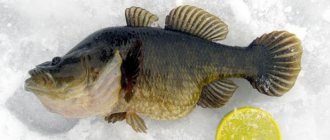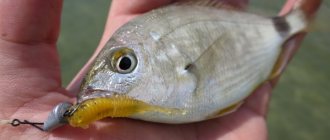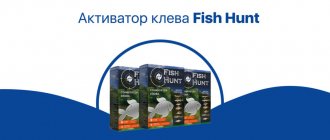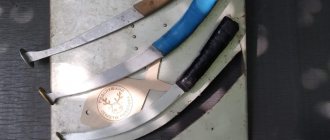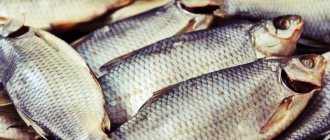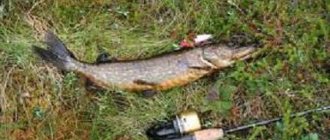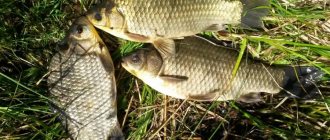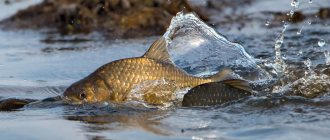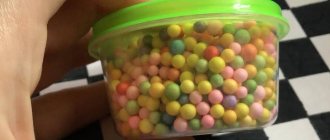Behavior of crucian carp in August
The advantage of catching crucian carp at the end of summer is that at this time the crucian carp begins to actively feed and gain fat. It’s as if he knows that in the fall all the vegetation and microorganisms of the reservoir will cease their vital activity, and he tries to eat his fill in order to calmly lie down for winter hibernation. This is especially noticeable in the last weeks of August.
The fish takes the bait much more decisively and generally feels comfortable in cooler water, and, therefore, becomes less cautious. It is interesting that it is during this period that the fish, taking the bait, takes it sharply to the side or drags it to the bottom, which is completely uncharacteristic when fishing in other periods.
The behavior of crucian carp in August largely depends on the climatic conditions of a particular region. The further north the reservoir in which the fish lives is located, the earlier it begins to look for places to hibernate, burrowing into the silt, which can be observed even in the second ten days of August. In this case, the crucian carp completely stops feeding, and, therefore, there is no chance of catching it. In the southern regions, fish sometimes remain active even at the beginning of September.
Lure
Here are some recommendations for using bait:
- You can buy it (various mixtures, including foreign ones), or prepare it yourself (different types of porridges, steamed grain, soaked bread).
- To attract fish, flavoring substances can be used: ground fried flax, mixed feed or makukh, less often honey or molasses. They are added to the bait, but try not to overdo it - this can have the opposite effect.
- To increase the bite, add live ingredients (chopped worms, maggots, bloodworms).
- When going fishing, take up to five kilograms of bait with you. Of this, up to three kilograms will be used to feed the fishing spot itself, put the rest in feeders (you can also put some live bait there).
- When feeding places, small balls are taken, which are either thrown into the water or scattered over feeders.
Best time for fishing
It is important to know when crucian carp become most active in search of food. As practice shows, the best catch can be achieved if you go fishing at 5 o’clock in the morning. The bite will continue for 4–5 hours, after which it will gradually begin to subside. This applies to the beginning of the month. In the last weeks of August, the fish, on the contrary, switch to daytime mode.
Important! A harbinger of a good catch is a light, warm morning rain.
Now you don’t have to deny yourself the pleasure of sleep, since the gear can be set up from 9 o’clock in the morning. In this case, fishing will be productive until 5 pm. In the last week of August, small fish stop biting, and mostly large specimens are caught on the hook.
What weather should you fish in?
For successful fishing, the fisherman should not only know the weather forecast for the time of fishing, but also analyze climate changes over the past few days. This will make it possible to get a general picture of the changes and, accordingly, estimate how active the bite will be. For example, at the beginning of August you can often experience quite hot weather. Crucian carp, although thermophilic, cannot tolerate extreme heat, so it goes deeper, which negatively affects the bite. At the end of the month the situation changes - cool days and nights activate the fish.
In addition to air temperature, atmospheric pressure also influences the bite. Its high level has a bad effect on crucian carp. At depth, water acquires increased density, and its upper layers contain less oxygen. At this time, the crucian carp simply freezes at depth, and all its vital processes are suspended. A sharp drop in pressure affects the behavior of the fish even worse - it can even lose orientation. The most favorable periods are considered to be periods when the pressure remains stably at the same level for several days, as well as days when it slowly decreases.
In August, the optimal level of atmospheric pressure should be around 745–752 mm Hg. Art., but if it is even a little lower, but stably stays at the same level, this also contributes to the bite. It should also be taken into account that during strong gusty or stormy winds, crucian carp practically do not feed. And fishing is quite difficult, since the wind forces the bait to move unnaturally, which scares the fish, and it is almost impossible to determine the bite.
Preparing gear for catching crucian carp
A variety of gear is suitable for catching crucian carp. True, float rods are used much less frequently. During this period, bottom equipment is more often used, on which fish bite more productively, gradually going into the depths.
Find out also about the features of catching crucian carp using corn.
Float rod
If you are a fan of fishing with a float rod, choose the option that is most suitable for the conditions of the reservoir. Any type can be used. For example, the most popular is the fly rod, but it is suitable for close-range fishing. If you plan to fish with long casting, which is more effective for fishing in August, it is better to take a match rod.
For fast-flowing river conditions, fishermen use a Bolognese fishing rod. To make fishing more effective, it is recommended to put two hooks with plant and animal bait on the tackle at once. Crucian carp will bite mostly on a worm or bloodworm, but the presence of, for example, pearl barley or mastyrka nearby will improve the bite.
Bottom gear
Bottom gear is best suited for catching crucian carp in August, away from the shore. Using them, you can return home with a good trophy.
These include:
- Ordinary donka. This is the simplest gear in design. It consists of a reel, fishing line, leashes with hooks and weight.
- Donka-zakidushka. A more complicated option. It contains a rod with guides and a reel, from which comes a fishing line with a sinker and leaders.
- Rubber. This is an improved version, the design of which, in addition to fishing line with leashes, includes an elastic band. This allows you to constantly place the equipment in the same place in the reservoir.
- Feeder. The tackle is similar to a donka, but its main difference is the presence of a feeder, which also serves as a sinker.
When fishing on a feeder with long casting, it is better to use special feeders made in the shape of a shuttlecock. Their flight range is 30% greater than that of conventional ones.
What does it bite on?
The best bait for crucian carp is considered to be a dung worm, which awakens a genuine appetite in the fish, as a result of which bites can be observed after each cast. Moreover, this attachment turns out to be effective both in river conditions and in lakes and ponds. An alternative is maggot, but this bait is not effective in all bodies of water. Its attractiveness largely depends on the natural fauna; it is most often used when fishing in lakes with stagnant water.
Did you know? Crucian carp really love the smell of garlic. Anglers use this to create a primitive but effective bait: they rub garlic on rocks and throw them into the fishing spot.
Another “tasty” option is bloodworms or beetle larvae. Animal baits are very effective in August, since during this period crucian carp are looking for food rich in protein. Even raw and boiled meat, cut into small pieces, will become a real treat for fish. Of the baits of plant origin, the most attractive for crucian carp are semolina, dough, canned corn, pearl barley, mastyrka, and bread. They are especially indispensable when fishing in the first half of August, when the water is still quite warm. Fish bite on pearl barley, corn and dough more often in the evening.
If you are going to fish with a float rod with two hooks, you can use different baits, for example, string a ball of bread on one, and a worm on the second. Small baits can be put on 2-3 pieces on one hook, making a kind of delicious “sandwiches”.
Features by season
Fishing technology does not differ at different times of the year. The only difference is in the type of complementary food selected: it depends on the behavior of the fish. In summer and spring she is more active and actively feeds on any food. In autumn and winter, you need to choose options with strong, enticing scents.
Spring
In the north, crucian carp sleeps almost until May, until it finally warms up; in the south and in the middle zone you can catch it almost all year round. During the flood period, fish begin to migrate en masse to small tributaries of rivers. While the fish is going and spawning, you can catch it with a worm and maggot; sometimes pearl barley with corn works well. In spring, the tastes of crucian carp are very fickle, so for each fishing trip you need to take several different preparations.
Summer
In the warm season, the fish actively go for bait. It is almost impossible to overfeed it, especially during the current. All that remains is to choose the best option for aromatics. Sweet fruity scents work best during this period. You can use synthetic odor and taste enhancers for these purposes, because the fish is spoiled by an abundance of food.
Crucian carp, 600 grams, caught in the summer using feeder tackle
However, you need to be careful here, because often small roaches destroy food without getting hooked. In this case, you can try fishing with peas, pearl barley or corn.
Autumn
The water becomes clearer, the activity of fish that are preparing for hibernation decreases. It is necessary to use heavier baits and in smaller quantities. In this case, semolina works well . It is worth adding particles of live food.
Attention should also be paid to smells. Dill, anise and fennel work well during this period, but gradually the fish begin to go deeper. Fishing is considered the most productive before the first cold weather sets in.
The best bait
Of course, any fishing begins with high-quality bait. Today you can buy a variety of ready-made mixtures in stores. But experienced fishermen more often use proven compositions made with their own hands. For example, one of the best baits is considered to be a mixture of sunflower cake, cookies, breadcrumbs, bloodworms and maggots. Animal filler should be no more than 10%. Vanillin, dill seeds or honey are added as flavoring agents, and clay acts as a binding component.
All ingredients must be thoroughly mixed until smooth. If you are going to catch crucian carp on a river with a current, it is better to place the mixture in a gauze bag. Another way to make good bait for crucian carp is to mix dough, the pulp of fresh rye bread and bloodworms. You can “season” the composition with sunflower oil or valerian.
Experienced fishermen sometimes prepare special bait - porridge with a rather complex composition. Although the process of preparing it is not so simple, it often turns out to be the most attractive for crucian carp.
Read also how to prepare pearl barley for fishing in a thermos.
It is done as follows:
- Add 100 g of millet to 300 ml of water and boil for 15 minutes. After boiling, add 1 tbsp. l. vegetable oil (preferably homemade) and 1/3 tsp. honey, mix.
- Pour 200 g of barley or corn grits into a separate bowl, add boiled millet and mix. Leave overnight for swelling.
- Immediately before fishing, add enough breadcrumbs so that the gruel acquires a thick consistency.
Lures for August fishing
Successful fishing for crucian carp begins with high-quality bait. Each experienced fisherman has his own secrets for making the mixture. Here are some proven compositions: First: • Store-bought bait for carp fish.
• Small food bloodworms (larvae of the long-running mosquito). • Maggot.
If the crucian carp does not take bait, you can add honey or vanilla sugar to it.
Second: • Hemp or sunflower cake. • Cookie. • Breadcrumbs.
• Bloodworm. • Maggot. Without this larva, catching crucian carp in August is almost impossible.
• Clay. • A little vanillin, or mashed dill seeds, or a couple of mashed green garlic arrows. Everything is thoroughly mixed.
If the reservoir has a current, the bait should be thrown into the water, tied in gauze. Third: • Dough. • Crumb of fresh rye bread.
• Bloodworm. Mix everything and roll the mixture into balls. Season with hemp, mint or anise oil.
Bloodworms and maggots in any composition should be no more than 10%. The crucian carp quickly gets used to this treat, going to the same place to feed every morning. In addition, you can bait the fish with steamed wheat, boiled corn, peas, and butter bread crumbs. All products must be fresh. It is important not to overfeed future prey - a well-fed crucian carp is reluctant to take bait. In this case, fishermen use the following trick: they rub the stones with garlic and throw them into the water. The fish, attracted by the strong smell, begins to actively grab the bait. It has been noticed that crucian carp reacts quickly to changes in complementary foods, so there is no need to be afraid to experiment. Crucian carp is a voracious and omnivorous fish, so you can use both animal and plant baits on the hook: • Red dung worms (the best option). • Maggots. • Bloodworm. • Burdock moth larvae. To ensure that the larvae stay on the hook better, they are first placed in a gauze bag and dipped in boiling water. • Small grasshoppers and large flies. • Raw and cooked meat, cut into squares. • Fresh bread crumbs, pancakes. • Boiled pasta, pearl barley, semolina.
If fishing is sluggish, you can try to make a “sandwich” for crucian carp - attach two bloodworms with a maggot in the middle. This combination also attracts the attention of the fish: a small worm, a maggot and a larger worm at the bottom. Alternating plant and animal bait gives good results.
[custom_ads_shortcode3]
Reasons for lack of bite
Since August is a rather difficult month for crucian carp, characterized by changes in weather, pressure and other indicators, it may well happen that you return from fishing with nothing.
Did you know? There is an opinion that the bite of crucian carp largely depends on what phase the Moon is in. The most successful fishing will be during the waning moon and on the new moon.
The reasons for this can be varied, namely:
- increased atmospheric pressure or its sudden changes;
- incorrect choice of nozzle that is not suitable for the conditions of the reservoir;
- strong wind;
- excessively hot days in the first half of August or very cold days in the second;
- an inappropriate place, for example, fishing in reed thickets at the end of summer will not bring anything good.
It should also be taken into account that the bite during the day is greatly influenced by the presence of other representatives of aquatic fauna in the reservoir. For example, if there is a pike in the river, the crucian carp will go out to feed exclusively at night, when it practically does not notice its proximity to the predator.
Inexperienced fishermen often think that crucian carp is a capricious fish. Actually this is not true. If you choose the right gear, bait and determine a good place, catching it will not be difficult. In addition, the process will bring a lot of pleasure, especially if you fish with hand-made equipment.
Installation of equipment
The three most common types of equipment are:
- asymmetrical loop,
- anti-twist,
- paternoster.
The first two are best used if you are fishing on hard ground. The latter is on soft, muddy (for example, a peat quarry). The paternoster will prevent the bait from diving into the mud if the feeder goes there.
Installing any of the above equipment will not be difficult:
Equipment with anti-twist
- Pass the fishing line through the anti-twist tube, with the longer end of the tube directed towards the leash;
- Place a stopper bead on the fishing line;
- Attach the swivel to the carabiner;
- Attach a feeder or sinker (at your discretion) to the part of the carabiner that is on the anti-twist;
- A leash is attached to the part of the carabiner that is attached to the fishing line.
Asymmetrical loop
- Fold part of the fishing line in half so that one part protrudes beyond the other by a length of 0.15 - 0.2 m;
- At the point where the fold is formed, tie a loop and an additional knot for security;
- Place a feeder on the protruding part;
- Connect the two ends of the fishing line and tie another knot;
- The resulting knot secures the equipment to the main line, and the other one secures the leash (with a clasp or a loop in a loop).
Paternoster
- Place 2 securely fixed stoppers on the fishing line at a distance of 30 to 50 centimeters from one another;
- Pull the swivel between the stoppers;
- To attach the leash to the end of the fishing line, attach a swivel along with a carabiner;
- To the swivel that is stretched between the stoppers, pieces of fishing line of different lengths, equipped with a feeder or sinker, are hooked.
